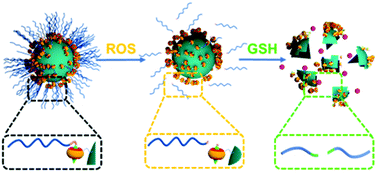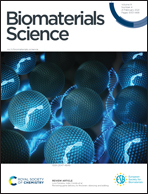Supramolecular nanomedicine for selective cancer therapy via sequential responsiveness to reactive oxygen species and glutathione†
Abstract
Cancer cells are generally immersed in an oxidative stress environment with a high intracellular reduction level. Thus, nanocarriers with sequential responsiveness to oxidative and reductive species, matching the traits of high oxidation in the tumor tissue microenvironment and high reduction potential inside cancer cells, are highly desired for specific cancer therapy. Herein, we report a supramolecular nanomedicine comprised of a reduction-responsive nanoparticle (NP) core whose surface was modified by an oxidation-responsive polyethylene glycol (PEG) derivative via strong host–guest interactions. In this delicate design, the PEGylation of NPs not only reduced their immunogenicity and extended systemic circulation, but also enabled oxidation-responsive de-PEGylation in the tumor tissues and subsequent intracellular payload release in response to glutathione (GSH) inside tumor cells. As a proof of concept, this supramolecular nanomedicine exhibited specific chemotherapeutic effects against cancer in vitro and in vivo with a decent safety profile.



 Please wait while we load your content...
Please wait while we load your content...